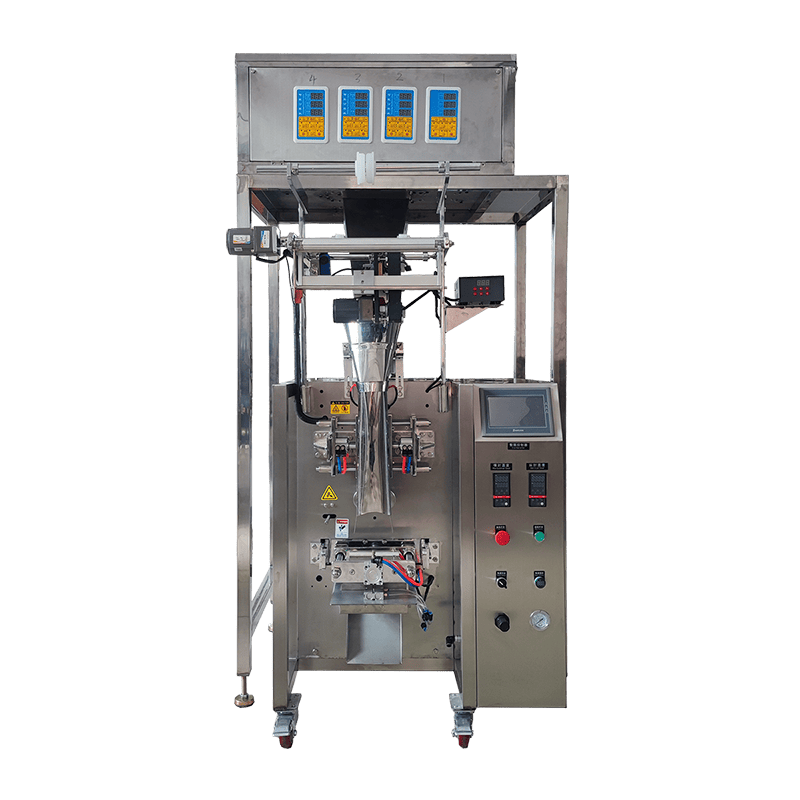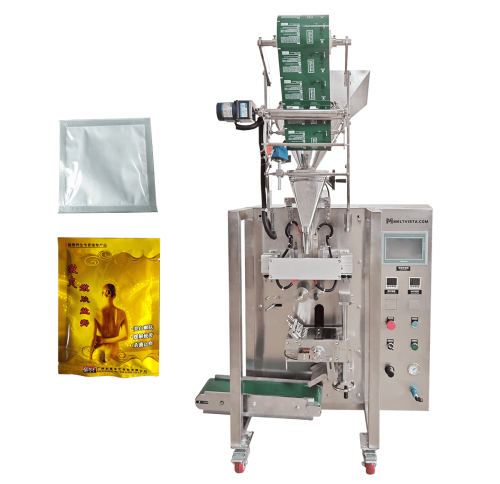
Weighing Filling Machine
| Model | MV-K240-DZ |
| Production Capacity | 25–35 bags/min (depending on material and weight) |
| Measuring Range | 1–100g |
| Measuring Method | Electronic Weighing |
| Bag Size | (L)30–150mm × (W)25–150mm |
| Sealing Type | Back seal, three-side seal, four-side seal (choose one) |
| Date Printing | Optional ribbon coding or thermal coding |
| Total Power | 1500W |
| Net Weight | 195KG |
| Power Supply | 220V/50–60Hz, 380V/50–60Hz |
| Packaging Materials | Aluminum foil composite film, plastic composite film, heat-seal nonwoven fabric, tea filter paper |
| Machine Dimensions | L865 × W660 × H1900mm |
MeltVista Weighing Filling Machine is designed for high efficiency with an automatic electronic weighing system, offering exceptional accuracy of 1%. It is capable of packing between 25 and 35 bags per minute, with a customizable weight range from 1g to 100g.
Equipped with 4 weighing heads, this machine can simultaneously mix up to 4 different materials into one bag, streamlining the packaging process. When packing a single material, it can boost the speed of packaging.
Additionally, the number of weighing heads can be customized to either add more materials or further increase packing speed, making it versatile and highly efficient. This machine is ideal for packaging materials like aluminum foil composite film, plastic composite film, heat-sealed nonwoven fabric, tea leaves, and more.
Perfect for multi-material packaging needs, the Weighing Filling Machine ensures accuracy, speed, and adaptability, offering tailored solutions for a variety of industries.
Weighing Filling Machine Guide
Features and Benefits What is a Weighing Filling Machine? Packaging Process How It Works Conclusion- High-Speed Packaging: Capable of packing 25-35 bags per minute, depending on the material and weight, ensuring fast production and high throughput for businesses.
- Precise Weighing System: The machine features an electronic weighing system with 1-100g weight range and an accuracy of 1%, providing consistent and reliable packaging results for various materials.
- Versatile Bag Sizes and Sealing Options: The machine supports a variety of packaging requirements with customizable bag sizes (L) 30-150mm and (W) 25-150mm. It can accommodate back-seal, three-side seal, and four-side seal configurations (choose one).
- Efficient Multi-Material Packaging: Equipped with 4 weighing heads, the machine allows the simultaneous packaging of up to 4 different materials in one bag. This versatility ensures faster and more efficient packaging, particularly for mixed products.
- Customizable Cutting and Coding Options: The cutting system includes flat cutters and serrated cutters, and the machine can be equipped with optional printing options, such as color band printing or heat-seal printing, for branding and product information.
- Powerful Performance: With a total power of 1500W, the machine ensures consistent and efficient operation for demanding packaging tasks.
- Compact and Robust Design: Despite its powerful performance, the machine has a compact structure with dimensions of L865 x W660 x H1900mm, making it suitable for different production environments. Its net weight of 195kg ensures stability during operation.
- Flexible Power Supply Options: Supports dual power options of 220V/50-60Hz or 380V/50-60Hz, allowing for seamless integration into various manufacturing setups.
- Wide Range of Packaging Materials: Compatible with a broad array of packaging materials such as aluminum foil composite film, plastic composite film, heat-sealed nonwoven fabric, and tea filter paper, making it suitable for industries like food, chemicals, and more.
- User-Friendly Operation: Designed to simplify the packaging process, making it ideal for customers who require high-speed, accurate, and multi-material packaging solutions.
A Weighing Filling Machine is an automated packaging system that precisely measures and fills products by weight, ensuring accuracy and consistency in industries such as food, pharmaceuticals, chemicals, and cosmetics. Unlike volume-based fillers, it uses load cells or precision scales to achieve high filling accuracy (typically ±0.1% to ±1%)
Basic Product Definition
It uses integrated scales or load cells to ensure each package contains the exact specified weight of product, making it ideal for:
- Granular products (coffee, nuts, grains)
- Powders (flour, protein, spices)
- Irregularly shaped items (pasta, pet food, hardware)
- Liquids & pastes (honey, sauces, cosmetics)
Key Features:
- High Accuracy (±0.1% to ±1% of target weight)
- Multi-Ingredient Mixing (e.g., seasoning blends, supplements)
- Speed (20–300 fills per minute, depending on type)
- Automated Rejection of under/overweight packages
Example: A snack company uses it to fill 50g almond packs with ±0.5g consistency, eliminating giveaway costs.
| Weighing Filler | Volumetric Filler |
|---|---|
| Measures by weight (grams/lbs) | Measures by volume (mL/cups) |
| Handles density variations | Requires uniform density |
| Higher accuracy for valuable products | Faster for low-cost bulk items |
Its Role in the Packaging Production Line
1. Key Functions in the Line
Precision Dosing:
- Measures exact weights (e.g., 100g coffee ±0.5g), critical for cost control and compliance (e.g., FDA net content rules).
- Compensates for product variability (density changes, irregular shapes).
Mixing & Blending:
- Multi-head systems (4–8 weigh heads) combine ingredients on-the-fly (e.g., protein powder + vitamins).
Quality Gatekeeper:
- Auto-rejects under/overweight packs via checkweighers or integrated sensors.
- Logs data for traceability (batch reports, compliance audits).
2. Integration Points in Production
[Upstream] → Weighing Filler → [Downstream]
Raw Material → Dosing → Sealing → Labeling → Boxing
After Material Handling:
- Receives pre-processed product (e.g., ground coffee, freeze-dried fruit).
Before Sealing/Labeling:
- Ensures correct weight before bags/jars move to sealers.
3. Industry-Specific Workflows
A. Food Production (e.g., Snack Mixes)
- Feeding: Nuts, seeds, and dried fruit enter via vibratory conveyors.
- Weighing: 4-head weigher blends 25% almonds + 25% cashews + 50% raisins.
- Filling: Deposits 200g ±1g into stand-up pouches.
- Rejection: Kicks out packs outside ±2g tolerance.
B. Pharmaceuticals (e.g., Powdered Medicine)
- Dosing: Fills 5.0g ±0.05g of antibiotic powder into sachets.
- Data Export: Records each weight for 21 CFR Part 11 compliance.
- Transfer: Passes filled sachets to a blister packer.
4. Impact on Efficiency
- Labor Reduction: Replaces 3–5 manual weighers per shift.
- Speed: Processes 2–5× faster than volumetric fillers for uneven products.
- Waste Reduction: Cuts giveaway by 3–8% vs. manual methods.
- Example: A pet food line boosts output from 800 to 2,000 bags/hour after installing a 6-head weigher.
5. Compatibility with Other Machines
| Connected Equipment | Purpose |
|---|---|
| Bagging Machines | Receives weighed product for sealing |
| Checkweighers | Verifies filler accuracy |
| Labelers | Applies weight/ingredient labels |
| Robotic Packers | Sorts filled bags into cartons |
6. When Is It Essential?
- ✔ High-value products (coffee, supplements) where overfilling = lost profit.
- ✔ Regulated industries (pharma, baby food) requiring weight documentation.
- ✔ Mixed formulations (spices, tea blends) needing ratio precision.
Pro Tip: Pair with X-ray inspection for foreign material detection after filling!
Here's a step-by-step breakdown of how raw materials are transformed into precisely filled, sealed bags, with the weighing filler as the centerpiece:
1. Raw Material Handling
Process:
- Bulk ingredients (powders, granules, etc.) are loaded into silos or hoppers.
- Screw/vibratory feeders transport material to the weighing system.
Key Role of Weigher:
- ▶ Pre-sorts clumps or irregular particles for consistent flow.
2. Precision Weighing & Filling
Process:
- Product enters the weighing filler's hopper (stainless steel for food/pharma).
- Load cells measure exact weight (e.g., 50g protein powder ±0.5g).
- For blends (e.g., spices), multiple weigh heads mix ratios automatically.
Critical Checks:
- ✔ Auto-rejection of under/overweight fills.
- ✔ Data logging for batch traceability (e.g., FDA compliance).
3. Bag Formation & Sealing
Process:
- Pre-made pouches or roll-fed film is formed into bags.
- Filled product is deposited, then heat-sealed (4-side seal for snacks, vacuum seal for coffee).
Weigher's Role:
- ▶ Syncs with baggers to prevent over/underfilling that could jam sealers.
4. Quality Control
Process:
- Checkweighers verify fill weight post-sealing.
- Vision systems inspect seals/print (e.g., expiry dates).
Cost Saver:
- ➔ Catches 99.9% of errors before boxing, reducing recalls.
5. Boxing & Palletizing
Process:
- Filled bags are counted and packed into cartons.
- Robots stack boxes onto pallets for shipping.
Weigher's Legacy:
- ▶ Ensures uniform box weights (no UPS/FedEx surcharges for light/heavy packages).
Visual Workflow
Raw Material → Weighing Filler → Bagging → Sealing → QC → Boxing → Shipping
↑
(Precision Dosing Hub)
Why the Weighing Filler is Indispensable
- Eliminates giveaway: Saves $50K+/year on high-value products like saffron or meds.
- Enables hybrid products: Protein + creatine + flavor in one bag.
- Complies with laws: Net weight labeling regulations (e.g., EU's FIC).
Real-World Example: A tea company uses a 10-head weigher to blend chamomile/lavender/mint (30/40/30% ratios), filling 120 bags/minute with ±0.3% accuracy.
A Step-by-Step Technical Breakdown
1. Product Feeding
Hopper Loading: Bulk material (powder, granules, etc.) is loaded into a stainless steel hopper.
Controlled Dispensing:
- Powders: Vibratory trays or auger screws feed product gently.
- Granules: Bucket elevators or conveyor belts transport items.
- Liquids: Precision pumps with flow meters regulate output.
- Key Tech: Anti-bridging systems (for clumpy powders) and deaeration (for fluffy products).
2. Weight Measurement
- Load Cells: High-precision sensors measure product weight (accuracy: ±0.1% to ±1%).
- Multi-Head Weighing (for speed):
- 4–8 independent weigh buckets work in parallel.
- Example: A 6-head weigher can make 300 weighments/minute.
- Smart Compensation: Adjusts for product density variations in real-time.
3. Filling Process
Single-Ingredient Mode:
- All weigh heads fill the same product (maximizes speed).
Multi-Ingredient Blending:
- Each head doses a different component (e.g., 30g oats + 20g nuts + 50g raisins).
Nozzle Selection:
- Powders: Anti-static spouts prevent cling.
- Granules: Wide-mouth funnels for free flow.
4. Quality Control
- Checkweigher Integration:
- Scans every filled bag/jar post-filling.
- Rejects under/overweight packs (±2% tolerance typical).
- Data Recording:
- Stores weight logs for compliance (e.g., FDA 21 CFR Part 11).
5. Downstream Integration
- Sealing: Filled bags move to heat sealers or cappers.
- Labeling: Weight/batch info printed automatically.
- Sorting: Robots pick accepted packs for boxing.
Visual Workflow
[1] Hopper → [2] Weigh Heads → [3] Filling Nozzle → [4] Checkweigher → [5] Sealing
↑ ↑ ↑
(Feeding) (Precision Measurement) (Reject if Out of Spec)
Key Innovations
- AI Optimization: Learns product behavior to reduce waste (e.g., adjusts vibration for sticky powders).
- Hygienic Design:
- CIP (Clean-in-Place) systems for pharma/food.
- No-tool disassembly for USDA inspections.
- Example: A nut brand uses load cell feedback to compensate for oil content variations in almonds, maintaining ±0.5g accuracy.
Why This Matters
- Cost Control: Saves 3–8% in material costs vs. volumetric filling.
- Regulatory Compliance: Meets net weight laws globally.
- Flexibility: Handles product changes in seconds (via HMI recipes).
Weighing Filling Machines represent the pinnacle of precision, efficiency, and automation in today's packaging industry. By combining advanced load-cell technology, multi-head weighing systems, and smart automation, these machines deliver:
- ✔ Unmatched Accuracy (±0.1–1% tolerance) for cost control and regulatory compliance.
- ✔ Blending Capabilities to create complex product mixes (e.g., supplements, spices).
- ✔ Seamless Integration with baggers, sealers, and checkweighers for end-to-end automation.
- ✔ Data-Driven Traceability to meet FDA, EU, and other global standards.
From food and pharmaceuticals to chemicals and pet food, weighing fillers eliminate manual errors, reduce giveaway waste, and boost production speeds by 200–500% compared to traditional methods.
Future-Ready Features like AI optimization and hygienic designs ensure these machines will remain indispensable as industries demand smarter, faster, and more sustainable packaging.
Ready to upgrade your line? [Contact us] for a free efficiency analysis tailored to your product!



